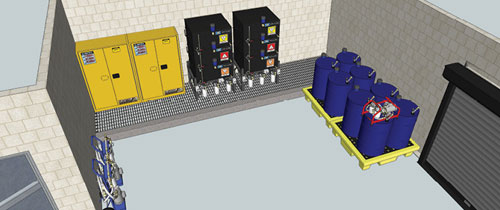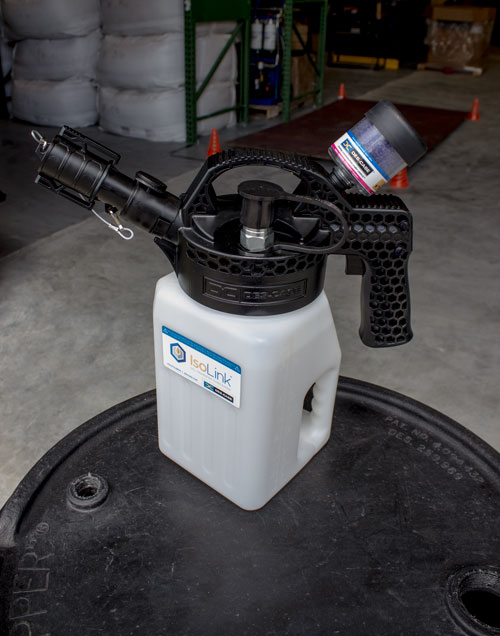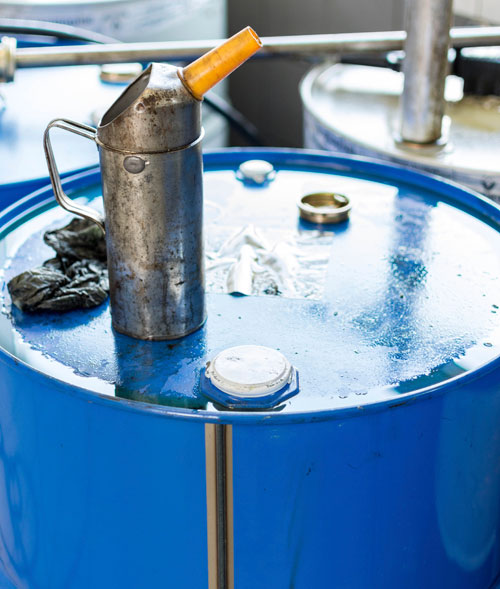
Storage and organization is critical in hydraulic fluid maintenance. An organized, well-labeled and coded lubrication room (above) simplifies fluid storage and ensures clean-running systems. Image courtesy of Des-Case
Just having a hydraulic fluid management plan in place doesn’t mean that you are doing it correctly. Managing your lubrication properly is critical in maintaining clean, efficient hydraulic systems, said Jason Kopschinsky, CMRP, director of reliability services for Des-Case.
“Not approaching lubrication in a holistic manner, including lubricant specifications, education, contamination control, preventive maintenance optimization, proper storage and handling, and condition monitoring, is poor lubrication management,” he said.
With that said, Kopschinsky offers five tips for hydraulic fluid management to ensure your hydraulic fluids have a long, clean life and keep your machines running as they are meant to.
- Optimize your lubricant inventory. Maintaining cool, clean hydraulic fluids starts when you receive new fluids. Kopschinsky said you should label your fluids clearly with color-coded lubricant tags to avoid cross contamination and comply with OSHA requirements. Some manufacturers provide a complete management system with specific colors and shapes on labels for specific types of fluids. This ID system should be applied to all tanks, top ups, funnels, application points and so on, said Kopschinksy.
- Organize your fluid storage. Labeling your fluids adds little value if they are not stored properly, said Kopschinsky. This starts in the lubrication room, which should be clean and organized, with closed containers. Not only will this reduce contamination, it will reduce waste as well.
-

Using an oil transfer container, like this system from Des-Case, is the cleanest way to transfer oil.
Make minor equipment modifications. Simple devices such as desiccant breathers, sample valves and sight gauges can go a long way in maintaining a clean, efficient system. They allow for easy inspections and screening. This will help ensure your fluid is long running and contaminant-free for its intended life.
“Modifications like this help maintain a totally-closed system while excluding and removing contamination,” Kopschinsky said. “They also ensure repeatable, efficient results and promote enhanced equipment and component reliability and performance.” - Give clear, precise instructions. ‘Sample fluid’ is not a procedure. “Maintenance procedures must be readily accessible at their point of use, and must contain a list of tools and supplies, cautions and warnings, and task-specific details,” Kopschinsky said.
- Make data-driven decisions. According to John S. Mitchell, author of the book Physical Asset Management, “When evaluated on a benefit/cost basis, approximately 50% of preventive maintenance tasks have essentially no value.” For example, time-based oil drains not only waste fluid that might still be clean and useful, but they also waste labor and time. This too, can cause environmental impacts by disposing of more fluid than is necessary in your facility.
In the end, said Kopschinsky, “Increasing lubrication PM frequencies without calculating the required frequency is poor lubrication.”
Des-Case
des-case.com
Filed Under: Filtration/Contamination Control, Fluid Power World Magazine Articles
